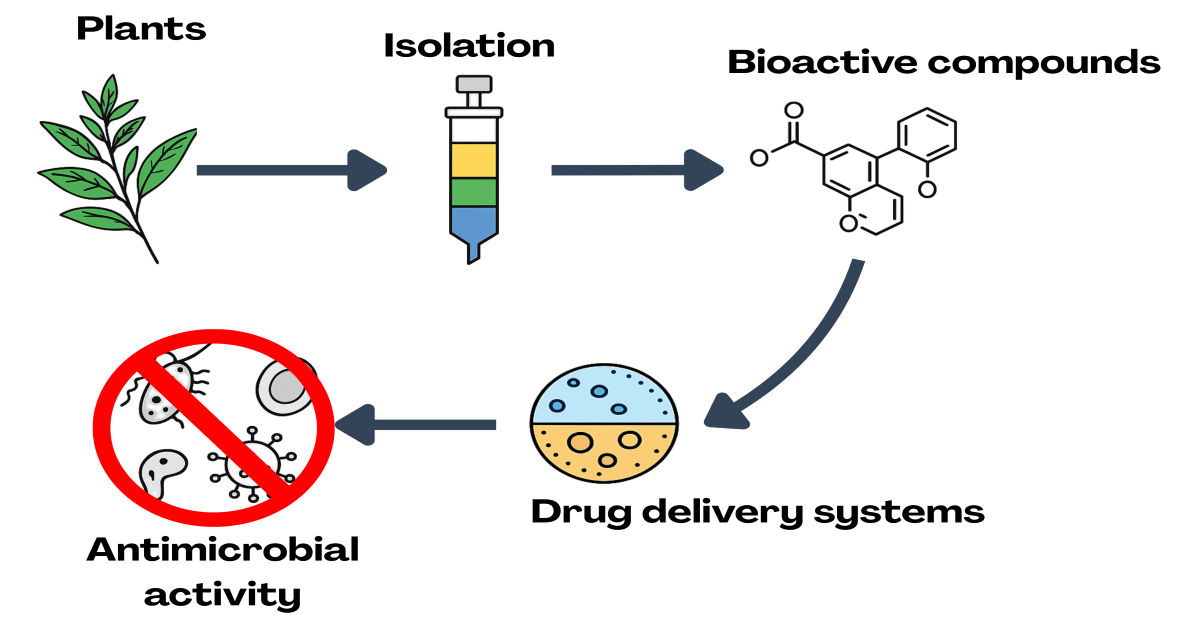Natural Products with Antimicrobial Activity and Their Pharmaceutical Delivery Systems
A special issue of Pharmaceutics (ISSN 1999-4923). This special issue belongs to the section "Drug Delivery and Controlled Release".
Deadline for manuscript submissions: 31 May 2026 | Viewed by 2940

Special Issue Editors
2. Institute of Chemistry and Metabolism of Drugs (IQUIMEFA), University of Buenos Aires – National Scientific and Technical Research Council, Buenos Aires, Argentina
Interests: neglected diseases; antimicrobial activity; natural compounds; plant extracts; terpenoids; flavonoids; Asteraceae
Special Issues, Collections and Topics in MDPI journals
2. IPLUSO/NICiTeS-ERISA-Escola Superior de Saúde Ribeiro Sanches, Rua do Telhal aos Olivais, 8-8ª, 1900-693 Lisboa, Portugal
Interests: natural products chemistry; structure-activity relationships
Special Issues, Collections and Topics in MDPI journals
2. Institute of Chemistry and Metabolism of Drugs (IQUIMEFA), University of Buenos Aires—National Scientific and Technical Research Council, Buenos Aires, Argentina
Interests: neglected diseases; terpenoids; flavonoids; Asteraceae, medicinal plants, bioactive compounds
2. Pharmaceutical Technology Research and Development Unit (UNITEFA), National University of Cordoba—National Scientific and Technical Research Council, Córdoba, Argentina
Interests: natural products; antimicrobial activity; photodinamic therapy; nanocomposites
Special Issue Information
Dear Colleagues,
We are pleased to invite you to submit your work to this Special Issue of Pharmaceutics titled "Natural Products with Antimicrobial Activity and Their Pharmaceutical Delivery Systems". This Special Issue will focus on the potential of natural products as antimicrobial agents and the development of innovative strategies for their delivery.
Natural products have long been a key source of compounds with antibacterial, antifungal, antiviral, and antiparasitic activity, offering promising therapeutic alternatives for infectious diseases. However, their clinical application is often limited by issues related to stability, bioavailability, and specificity, highlighting the need for advancements in drug delivery systems.
This Special Issue aims at gathering high-quality research and review articles on topics including, but not limited to, the following:
- New sources of natural products with antimicrobial activity and their characterization with potential therapeutic applications in infectious diseases.
- Development of advanced delivery systems, such as nanoformulations, lipid-based carriers, smart polymers, and other innovative approaches to enhance efficacy and safety.
Please note that studies solely focused on crude plant extracts, without identification of bioactive compounds, will not be considered for publication.
We look forward to your valuable contributions!
Dr. Valeria Patricia Sülsen
Prof. Dr. Maria Do Céu Costa
Dr. Jerónimo Ulloa
Dr. Juliana Marioni
Guest Editors
Manuscript Submission Information
Manuscripts should be submitted online at www.mdpi.com by registering and logging in to this website. Once you are registered, click here to go to the submission form. Manuscripts can be submitted until the deadline. All submissions that pass pre-check are peer-reviewed. Accepted papers will be published continuously in the journal (as soon as accepted) and will be listed together on the special issue website. Research articles, review articles as well as short communications are invited. For planned papers, a title and short abstract (about 250 words) can be sent to the Editorial Office for assessment.
Submitted manuscripts should not have been published previously, nor be under consideration for publication elsewhere (except conference proceedings papers). All manuscripts are thoroughly refereed through a single-blind peer-review process. A guide for authors and other relevant information for submission of manuscripts is available on the Instructions for Authors page. Pharmaceutics is an international peer-reviewed open access monthly journal published by MDPI.
Please visit the Instructions for Authors page before submitting a manuscript. The Article Processing Charge (APC) for publication in this open access journal is 2900 CHF (Swiss Francs). Submitted papers should be well formatted and use good English. Authors may use MDPI's English editing service prior to publication or during author revisions.
Keywords
- antibacterial
- antiparasitic
- antifungal
- antiviral
- natural compounds
- drug delivery
Benefits of Publishing in a Special Issue
- Ease of navigation: Grouping papers by topic helps scholars navigate broad scope journals more efficiently.
- Greater discoverability: Special Issues support the reach and impact of scientific research. Articles in Special Issues are more discoverable and cited more frequently.
- Expansion of research network: Special Issues facilitate connections among authors, fostering scientific collaborations.
- External promotion: Articles in Special Issues are often promoted through the journal's social media, increasing their visibility.
- Reprint: MDPI Books provides the opportunity to republish successful Special Issues in book format, both online and in print.
Further information on MDPI's Special Issue policies can be found here.









